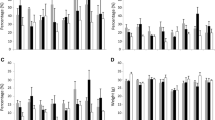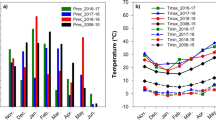Abstract
Zymoseptoria tritici is a major fungal pathogen which can cause serious loss in bread-making wheat. In this study, field experiments were conducted over two growing seasons to evaluate the effect of fungicide treatment (1- or 2-sprays of prothioconazole and tebuconazole) on Septoria leaf blotch (SLB) severity, wheat grain yield, hectolitre weight, crude protein and on the SDS (sodium dodecyl sulphate) sedimentation test. The influence of cultivar resistance on fungicide efficacy under Mediterranean conditions was also analysed. The results showed that in years drier than average, fungicide application might not be recommended as SLB severity would be low and the fungicide application itself could reduce grain yield. At high-severity of SLB, one spray of prothioconazole + tebuconazole applied between anthesis and maturation reduced disease severity by more than 50 % and increased grain yield by approximately 20 %. Fungicide treatment did not affect the quality parameters of the grain, measured as crude protein and by the SDS sedimentation test, under these experiment conditions.




Similar content being viewed by others

References
AOAC. (2012). Official methods of analysis (19th ed.). Washington DC: Association of Official Analytical Chemists.
Arama, P. F., Parlevliet, J. E., & van Silfhout, C. H. (1999). Heading date and resistance to Septoria tritici blotch in wheat not genetically associated. Euphytica, 106, 63–8.
Arraiano, L. S., Brading, P. A., Dedryver, F., & Brown, J. K. M. (2006). Resistance of wheat to septoria tritici blotch (Mycosphaerella graminicola) and associations with plant ideotype and the 1BL-1RS translocation. Plant Pathology, 55, 54–61.
Arraiano, L. S., Balaam, N., Fenwick, P. M., Chapman, C., Feuerhelm, D., Howell, P., et al. (2009). Contributions of disease resistance and escape to the control of Septoria tritici blotch of wheat. Plant Pathology, 58, 910–922.
Ashby, P. (2011). Feedback from the EPPO Septoria tritici azole resistance workshop 2010. Aspects of Applied Biology, 106, 97–101.
Axford, D. W. E., McDermott, E. F., & Redman, D. G. (1979). Note on the sodium dodecyl sulphate test of breadmaking quality: comparison with Pelshenke and Zeleny test. Cereal Chemistry, 56, 582–584.
Bancal, M. O., Robert, C., & Ney, B. (2007). Modelling wheat growth and yield losses from late epidemics of foliar diseases using loss of green area per layer and pre-anthesis reserves. Annals of Botany, 100, 777–789.
Beyer, M., El Jarroudi, M., Junk, J., Pogoda, F., Dubos, T., Görgen, K., et al. (2012). Spring air temperature accounts for the bimodal temporal distribution of Septoria tritici epidemics in the winter wheat stands of Luxembourg. Crop Protection, 42, 250–255.
Blandino, M., & Reyneri, A. (2009). Effect of fungicide and foliar fertilizer application to winter wheat at anthesis on flag leaf senescence, grain yield, flour bread-making quality and DON contamination. European Journal of Agronomy, 30, 275–282.
Buchenauer, H., & Röhner, E. (1981). Effect of triadimefon and triadimenol on growth of various plant species as well as on gibberellin content and sterol metabolism in shoots of barley seedlings. Pesticide Biochemistry and Physiology, 15, 58–70.
Burke, J. J., & Dunne, B. (2008). Field testing of six decision support systems for scheduling fungicide applications to control Mycosphaerella graminicola on winter wheat crops in Ireland. Journal of Agricultural Science, 146, 415–428.
Camacho-Casas, M. A., Kronstad, W. E., & Scharen, A. L. (1995). Septoria tritici resistance and associations with agronomic traits in a wheat cross. Crop Science, 35, 971–976.
Cruz de Carvalho, P. (2010). Catálogo Nacional de Variedades. Ministério da Agricultura do Desenvolvimento Rural e das Pescas. Lisboa: Direcção Geral de Agricultura e Desenvolvimento Rural.
Dimmock, J. P. R. E., & Gooding, M. J. (2002a). The influence of foliar diseases and their control by fungicides on the protein concentration in wheat grain; a review. Journal of Agricultural Science, 138, 349–366.
Dimmock, J. P. R. E., & Gooding, M. J. (2002b). The effects of fungicide on Hagberg falling number and blackpoint in winter wheat. Crop Protection, 21, 475–487.
Eyal, Z. (1981). Integrated control of septoria diseases of wheat. Plant Disease, 65, 763–768.
Eyal, Z., Scharen, A. L., Prescott, J. M., & van Ginkel, M. (1987). The septoria diseases of wheat: Concepts and methods of disease management. Mexico: D.F., CIMMYT.
FAO, 2012. Food and Agriculture Organization of the United Nations, http://faostat.fao.org/default.aspx.
Ferree, D. C., Hall, F. R., Krause, C. R., Roberts, B. R., & Brazee, R. D. (1999). Influence of pesticides and water stress on photosynthesis and transpiration of apple. fruit crops: a summary of research 1998. Ohio State University, Extension Research Circular, 299, 34–46.
Gieco, J. O., Dubcovsky, J., & Aranha Camargo, L. E. (2004). Interaction between resistance to Septoria tritici and phenological stages in wheat. Scientia Agricola, 61, 422–426.
Gopi, R., Sridharan, R., Somasundaram, R., Lakshmanan, G. M. A., & Panneerselvam, R. (2005). Growth and photosynthetic characteristics as affected by triazoles in Amorphophallus ampanulatus Blume. General and Applied Plant Physiology, 31, 171–180.
Herrmann, T. J., Bowden, R. L., Loughin, T., & Bequette, R. K. (1996). Quality response to the control of leaf rust in Karl hard red winter wheat. Cereal Chemistry, 73, 235–238.
Hunter, T., Coker, R. R., & Royle, D. J. (1999). The teleomorph stage, Mycosphaerella graminicola, in epidemics of Septoria tritici blotch on winter wheat in the UK. Plant Pathology, 48, 51–57.
Jonsson, J. O. (1991). Wheat breeding against facultative pathogens. Sveriges Utsadesforenings Tidskrift, 101, 89–93.
Jordan, V. W. L. (1992). Nitrogen and fungicide interactions in breadmaking wheat. London: Home-Grown Cereals Authority.
Kurt, S., & Tok, F. M. (2006). Influence of inoculum concentration, leaf age, temperature, and duration of leaf wetness of Septoria blight of parsley. Crop Protection, 25, 556–561.
Parsons, D. J., & te Beest, D. (2004). Optimising fungicide applications on winter wheat using genetic algorithms. Biosystems Engineering, 88, 401–410.
Paveley, N. D., Lockley, D., Vaughan, T. B., Thomas, J., & Schmidt, K. (2000). Prediction effective fungicide doses through observation of leaf emergence. Plant Pathology, 49, 748–766.
Peppler, S., Gooding, M. J., Ford, K. E., & Ellis, R. H. (2005). A temporal limit to the association between flag leaf life extension by fungicides and wheat yields. European Journal of Agronomy, 22, 363–373.
Petit, A. N., Fontaine, F., Vatsa, P., Clément, C., & Vaillant-Gaveau, N. (2012). Fungicide impacts on photosynthesis in crop plants. Photosynthesis Research, 111, 315–326.
Pietravalle, S., Shaw, M. W., Parker, S. R., & van den Bosch, F. (2003). Modelling of relationships between weather and Septoria tritici epidemics on winter wheat: a critical approach. Phytopathology, 93, 1329–1339.
Ruske, R. E., Gooding, M. J., & Jones, S. A. (2003). The effect of adding picoxystrobin, azoxystrobin and nitrogen to a triazole program on disease control, flag leaf senescence, yield and grain quality of winter wheat. Crop Protection, 22, 975–987.
Ruske, R. E., Gooding, M. J., & Dobraszczyk, D. J. (2004). Effects of triazole and strobilurin fungicide programmes, with and without late-season nitrogen fertiliser, on the baking quality of Malacca winter wheat. Journal of Cereal Science, 40, 1–8.
Sebei, A., & Harrabi, M. (2008). Assessment of virulence variability in Septoria tritici isolates and resistance of selected durum wheat cultivars. Turkish Journal of Plant Protection, 3, 11–17.
Serrago, R. A., Carreterim, R., Bancal, M. O., & Miralles, D. J. (2011). Grain weight response to foliar diseases control in wheat (Triticum aestivum L.). Field Crops Research, 120, 352–359.
Simón, M. R., Worland, A. J., & Struik, P. C. (2004). Influence of plant height and heading date on the expression of the resistance to Septoria tritici blotch in near isogenic lines of wheat. Crop Science, 44, 2078–2085.
Slafer, G. A., & Rawson, H. M. (1994). Sensivity of wheat phasic development to major environmental factors: a re-examination of some assumptions made by physicologist and modelers. Australian Journal of Plant Physiology, 21, 393–426.
te Beest, D. E., Shaw, M. W., Pietravalle, S., & van den Bosch, F. (2009). A predictive model for early-warning of Septoria leaf blotch on winter wheat. European Journal of Plant Pathology, 124, 413–425.
van Baalen, M., & Sabelis, M. W. (1995). The dynamics of multiple infections and the evolution of virulence. American Naturalist, 146, 881–910.
Xia, X. J., Huang, Y. Y., Wang, L., Huang, L. F., Yu, Y. L., Zhou, Y. H., et al. (2006). Pesticides-induced depression of photosynthesis was alleviated by 24-epibrassinolide pretreatment in Cucumis sativus L. Pesticide Biochemistry and Physiology, 86, 42–48.
Zadoks, J. C., Chang, T. T., & Konzak, C. F. (1974). A decimal code for the growth stages of cereals. Weed Research, 14, 415–421.
Zhang, C. J., Chen, G. X., Gao, X. X., & Chu, C. J. (2006). Photosyntetic decline in flag leaves of two field-grown spring wheat cultivars with different senescence properties. South African Journal of Botany, 72, 15–23.
Acknowledgments
The authors would like to thank the Portuguese INRB-INIA staff for their contribution to this study, and Teodoro García-White for his invaluable help in laboratory work.
Author information
Authors and Affiliations
Corresponding author
Rights and permissions
About this article
Cite this article
Rodrigo, S., Cuello-Hormigo, B., Gomes, C. et al. Influence of fungicide treatments on disease severity caused by Zymoseptoria tritici, and on grain yield and quality parameters of bread-making wheat under Mediterranean conditions. Eur J Plant Pathol 141, 99–109 (2015). https://doi.org/10.1007/s10658-014-0527-1
Accepted:
Published:
Issue Date:
DOI: https://doi.org/10.1007/s10658-014-0527-1



